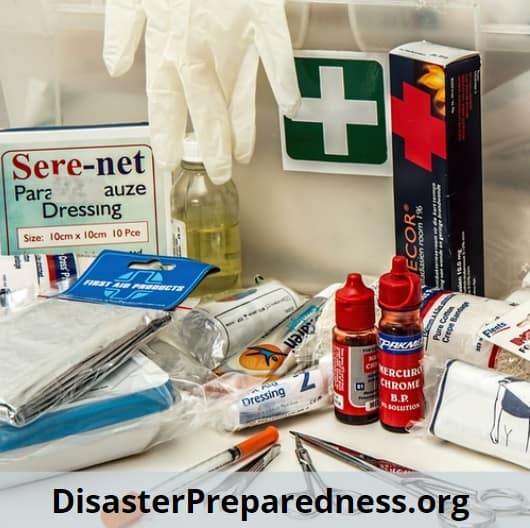Cuts, Scrapes, Blisters, Burns, Puncture Wounds, Severe Bleeding & Bruises

Skin Injuries
It’s not unusual to suffer from either major or minor skin injuries during a disaster situation. It’s always advisable to seek medical help when you’ve suffered from any injury, but that isn’t always possible during a disaster. Here are some guides to dealing with skin injuries with the help of your well-organized, well-prepared disaster preparedness first aid kit!
Cuts and Scrapes
Small skin injuries like cuts and scrapes are common during a disaster. First off, you should try to stop the bleeding. Often, minor cuts and scrapes stop bleeding all by themselves but if the bleeding continues, apply pressure to the injury with a bandage or a clean cloth.
Once the bleeding has stopped, wash the wound with clean water or an antiseptic wipe. If you can see any bits of dirt or debris, try to remove them using a cloth or tweezers, if necessary.
Lastly, apply a layer of antibiotic cream to help prevent infection before covering and sealing the wound with a clean bandage.
Blisters
 Blisters are nature’s way of forming a natural barrier to bacteria, decreasing the chance of infection on our skin. Don’t puncture a blister unless it is causing extreme pain. Simply cover the blister with an adhesive bandage to protect it and keep it from being inadvertently lanced.
Blisters are nature’s way of forming a natural barrier to bacteria, decreasing the chance of infection on our skin. Don’t puncture a blister unless it is causing extreme pain. Simply cover the blister with an adhesive bandage to protect it and keep it from being inadvertently lanced.
If you need to drain a blister to relieve pain, make sure that you start by washing your hands with warm water and soap. Next, swab the blister with alcohol or iodine.
Sterilize whatever you’re going to use to puncture the blister, either by fire or an alcohol wipe. Make several small pricks close to the edge of the blister and press gently to allow the fluid to drain, but don’t try to remove the skin.
Finally, apply some antibiotic ointment and cover with a bandage or wound wrap to prevent infection.
Burns
Burns can be very painful. Even relatively minor burns can cause a good deal of discomfort! The first thing to do is to cool the burn by holding it under cool, running water. Do not put ice on it. If running water is unavailable, pour the cool water in a bowl and immerse the burn there. If you don’t have any cool water, you can use a cold compress.
After you’ve taken some of the heat away (which could take up to 10 or 15 minutes), cover the burn with a sterile gauze bandage from your first aid disaster supplies kit. Try to keep the bandage loose so that you don’t put lots of pressure on the skin. You can also take a little over-the-counter pain relief if necessary like ibuprofen or aspirin.
Puncture Wounds
Puncture wounds don’t usually bleed that much and they often stop all by themselves. This does not, however, mean that you don’t need to treat them.
As with other skin injuries, the first step is to stop the bleeding if necessary using a clean cloth or bandage and pressure. Next, make sure that the wound is clean using water and an antiseptic wife. Tweezers can be used to remove any remaining particles, though be sure to clean the tweezers with alcohol first.
Lastly, apply a little antibiotic cream and cover the wound to prevent infection.
Severe Bleeding
Severe bleeding can cause real problems during some type of disaster situation when you can’t get emergency medical help. It’s important that you wash your hands and wear gloves before trying to stop the bleeding to avoid infection. Never try to push any displaced organs back into place. Without medical training, you’re limited on what you can do for the victim.
Cover the wound with a dressing. The injured person should be laid down and covered over the prevent loss of body heat with the legs slightly elevated or the head lower than the trunk. Any small bits of dirt and debris can be removed, but don’t try to remove anything which is large or deeply embedded. Try to stop the bleeding by applying pressure with a clean washcloth or gauze.
Apply pressure directly to the wound until the bleeding stops with a sterile bandage for a minimum of twenty minutes, then bandage tightly to keep the pressure on (without being tempted to check whether the bleeding has stopped). Don’t remove this bandage. If blood seeps through, add another layer of bandage on top.
Seek medical attention as soon as you are able.
Bruises
Bruises are quite common during a disaster situation. If possible, the injured area should be elevated and an ice pack or cold pack should be applied and the area. Try to rest as much as possible to allow the bruise to heal. Some form of pain relief (like ibuprofen) may be taken if required.
Pre-Made First Aid Kits
There are a number of pre-made first aid kits available online for purchase. If you don’t want to go through the hassle of putting together a kit yourself, consider one of these options: